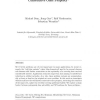Free Online Productivity Tools
i2Speak
i2Symbol
i2OCR
iTex2Img
iWeb2Print
iWeb2Shot
i2Type
iPdf2Split
iPdf2Merge
i2Bopomofo
i2Arabic
i2Style
i2Image
i2PDF
iLatex2Rtf
Sci2ools
124
Voted
JDA
2008
2008
Red-blue covering problems and the consecutive ones property
Set Cover problems are of core importance in many applications. In recent research, the "red-blue variants" where blue elements all need to be covered whereas red elements add further constraints on the optimality of a covering have received considerable interest. Application scenarios range from data mining to interference reduction in cellular networks. As a rule, these problem variants are computationally at least as hard as the original set cover problem. In this work we investigate whether and how the well-known consecutive ones property, restricting the structure of the input sets, makes the red-blue covering problems feasible. We explore a sharp border between polynomial-time solvability and NP-hardness for these problems. Key words: Set Cover, Hitting Set, Minimum Membership Set Cover, Minimum Degree Hypergraph, NP-completeness Preprint submitted to Elsevier 30 November 2007
Related Content
| Added | 13 Dec 2010 |
| Updated | 13 Dec 2010 |
| Type | Journal |
| Year | 2008 |
| Where | JDA |
| Authors | Michael Dom, Jiong Guo, Rolf Niedermeier, Sebastian Wernicke |
Comments (0)

